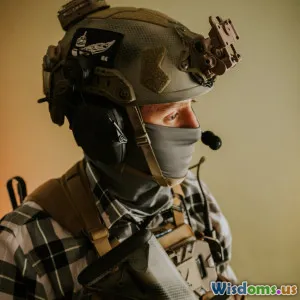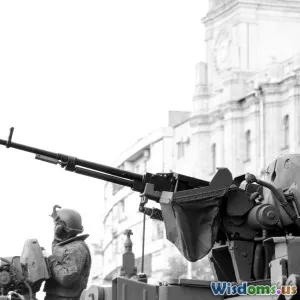
Enhancing Soldier Performance Through Simulations
8 min read Explore how military simulations are revolutionizing soldier performance and training. (0 Reviews)
Enhancing Soldier Performance Through Simulations
Introduction
In a world where every second matters on the battlefield, the quest to enhance soldier performance has taken center stage. Military leaders and researchers alike are leveraging advanced simulation technologies to prepare soldiers for modern warfare. This robust approach not only improves combat readiness but also revolutionizes training methodologies, making it an integral component of military operations today. By immersing soldiers in environments that replicate real-world challenges, military simulations are transforming how armed forces approach training, decision-making, and recovery.
The Evolution of Military Simulations
Historical Context
Since the inception of warfare, strategists have used mock battles to prepare soldiers for combat. However, the advent of technology has significantly changed the landscape of military training. In the early 20th century, rudimentary physical simulations focused on troop movements and battle strategies; today, they have evolved into advanced virtual reality (VR) and augmented reality (AR) systems.
For example, full-scope flight simulators developed for pilot training have been crucial in operational readiness. According to a report from the U.S. Air Force, pilots who trained on simulators encountered 25% fewer critical errors in real-time scenarios than those who had not, showcasing the profound impact of an immersive training environment.
The Rise of VR and AR
The incorporation of VR and AR technology allows for rich, interactive training scenarios that engage soldiers’ cognitive skills in realistic contexts. With VR, soldiers can experience combat situations firsthand, perfecting their skills without the inherent risks of a live environment. The U.S. Army has invested heavily in technologies such as the Synthetic Training Environment (STE), designed to replicate multi-domain operational environments. STE creates realistic scenarios where soldiers can interact, communicate, and strategize, preparing them thoroughly for actual deployments.
Benefits of Military Simulations
Improved Skill Acquisition
Military simulations facilitate engaging learning experiences where skills can be practiced repetitively without the dangers associated with live training. These systems deliver immediate feedback, enabling soldiers to understand their mistakes instantly. For example, the U.S. Army's Integrated Training Environment (ITE) immerses units in complex environments where they can adapt and refine their tactics in real-time.
Enhancing Decision-Making
In the modern battlefield, quick decision-making can be the difference between life and death. Military simulation exercises incorporate elements of unpredictability and stress similar to real combat scenarios, honing soldiers’ decision-making capabilities under pressure. For instance, during training exercises, the Quick Decision Drill (QDD) system allows soldiers to encounter rapidly changing variables, thereby training them to respond effectively amid chaos. Data shows that soldiers trained in high-stakes simulations demonstrated a 40% improvement in decision response time compared to those in traditional training formats.
Psychological Resilience
Combat stresses not only physical capabilities but also mental endurance. Immersive simulations allow soldiers to grapple with psychological challenges they may face in real combat situations, such as fear, exhaustion, and uncertainty. Research has indicated that facing simulated combat scenarios aids soldiers in developing coping mechanisms for acute stress reactions, ultimately fostering mental resilience necessary for warzones.
Joint Operations and Coordination
The complexity of modern warfare necessitates collaboration across multiple branches of service (land, sea, air). Simulations enable joint operational exercises where different military branches can train collectively. The Coalition Warrior Interoperability Exercise (CWIX), for instance, improves the synergy among NATO forces, ensuring that various military platforms function correctly together in the heat of battle.
Real-World Examples
Project Convergence
The U.S. Army's Project Convergence combines simulation technology with artificial intelligence to redefine how military personnel approach both training and tactical decision-making on the battlefield. In recent drills, AI-run simulations analyzed past engagements to create training environments tailored to specific soldier needs. The exercise resulted in increased operational effectiveness by identifying weaknesses and allowing for targeted improvements in soldier performance.
Navy's Advanced Combat Training Strategy
Similarly, the U.S. Navy has been employing simulation-driven training solutions through its live, virtual, and constructive (LVC) training framework. The framework bridges the gap between actual live operations and computer-generated environments, allowing naval forces to engage and prepare effectively in an environment that closely mirrors a kinetic battle plan.
Future Prospects
As technological advancements persist, the potential for further enhancement in military simulations lies on the horizon. Future innovations are expected to integrate machine learning and artificial intelligence more deeply into simulation platforms, empowering adaptive learning environments that cater to each soldier’s unique developmental path.
Moreover, the integration of biometric sensors could provide real-time physiological data, further refining individual training regimens based on stress responses and stamina, enabling even deeper psychological conditioning.
Ethical Considerations
The evolution of simulation technology also poses ethical dilemmas regarding training and combat scenarios. The ability to train without facing real consequences, combined with AI’s autonomy, raises questions about the impact on soldiers' moral reasoning in high-pressure combat situations. Ongoing discussions focus on establishing guidelines for simulation use in training, ensuring that ethical standards align with the militaristic development.
Conclusion
In summation, the rise of military simulations marks a pivotal change in how armed forces prepare their soldiers for warfare. These advanced tools nurture skill acquisition, decision-making, psychological resilience, and coordinated actions across various military services. Integration of technologies, such as VR, AR, AI, and machine learning, signals immense possibilities for the future of military training, propelling soldiers to new performance heights. As the face of warfare continues to evolve, simulations will be at the forefront, ensuring that soldiers are equipped to meet the demands of an increasingly complex and perilous combat landscape.
Continued investment in these realms not only amplifies soldier competence but also shapes the future of military operations. It's through such groundbreaking technologies that future conflicts can be navigated with enhanced precision, improved outcomes, and, ideally, a reduced human toll.
Rate the Post
User Reviews
Popular Posts





















